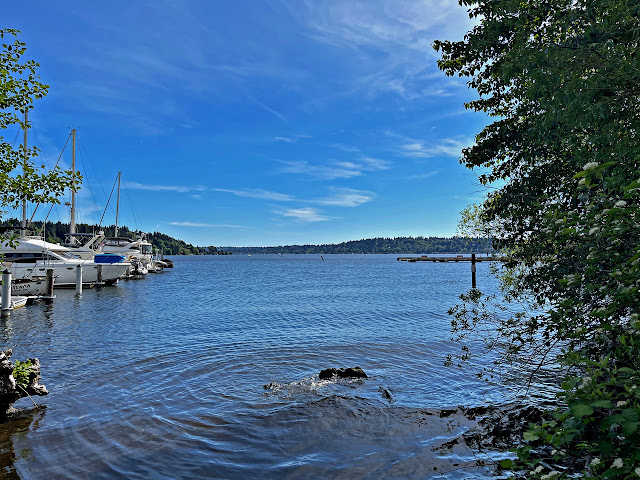 |
| L-R: Christopher Mosier (behind), Julie Povick, Bradley Cabe, Leslie Brinson, Mei-shiou Lin, Lauren Hadley, and Colt Fry |
By Pam Cross
The
Shoreline Planning Commission Meeting Thursday, June 6, 2024 was held in the Council Chamber using a hybrid format where both in-person and online attendance is allowed.
The Commissioners are Christopher Mosier (absent), Leslie Brinson (absent), ,Julie Povick, Bradley Cabe, Mei-shiou Lin, and Colt Fry (absent)
This was an update to the 2024 Comprehensive Plan - Middle Housing discussion of the following issues from House Bill 1110:
- Tier Options
- Alternative Compliance
- Draft Land Use Maps
Staff Presentation by
- Andrew Bauer, Planning Director
- Elise Keim, Planning Manager
- Steve Szafran, Senior Planner
- Emily Larson, Otak
Otak, Inc. is an award-winning urban design, architecture, planning and engineering firm. They are involved in the Ronald Bog Basin Study and The Shoreline Interurban Trail.
TIER OPTIONS
 |
| TIER 2 |
At the Planning Commission meeting of May 20, 2024 it was stated that Shoreline’s population of approximately 61,120 designates it as Tier 2. The Commission discussed whether the city should move to a Tier 1 designation now in order to avoid having to change everything as our city continues to grow.
Staff recommended staying with Tier 2 for a variety of reasons including anticipated time to reach Tier 1 status (estimated 12 years), and allowing more time to scale up the city infrastructure.
 |
| TIER 2.5 |
At this June 6th meeting, a Tier 2.5 was added for discussion purposes.
The change from Tier 2 to Tier 2.5 affects significantly more areas of Shoreline.
Additionally, 2.5 adds “High Activity Areas” and an associated 1/4 mile buffer. High Activity areas include commercial centers or nodes with grocery stores, restaurants, and/or retail. Civic facilities such as a library or post office would also be included.
HB1110 - Standard or Alternative Compliance
In addition to the new base requirement for middle housing, Alternative Compliance options are available.
Risk of Displacement
The staff report defines Displacement as when a household is forced or pressured to move due to reasons beyond the householder’s control.
- Physical: demolition, eviction, natural disaster
- Economic: rising rents or property taxes
- Cultural: cultural institutions/communities leave
Staff recommended exempting lots subject to sea level rise and flood hazards.
Other critical areas will be protected with regulations. And higher displacement risk can be addressed through policy and implementation. Additional details are included in the staff report.
LAND USE
The new land use designations will also become the zoning designations eliminating the confusion when trying to comply with both zoning and land use.
This is a work in progress. While it was stated that current R-4 and R-6 would be changed to NR3 (Neighborhood Residential 3), there are lots currently zoned R-4 or R-6 that meeting criteria to move to N2 would be changed to N2 which is more intense than NR3 with higher building heights, more allowed types of housing, and some small commercial.
It’s important to keep in mind that R-4, which was based on population, has less density than R-6 or R-18. The number gets higher as density increases.
But NR1 is “the most intense neighborhood residential zone where building heights may exceed three stories, with more types of commercial.” (Staff report)
The number gets lower as density increases.
The only speaker at public comment was Jonathan Lounds, representing the Master Builders Association of King and Snohomish Counties. He stated the MBA prefers changing to Tier 1. The MBA appreciates Tier 2.5 being considered but suggests allowing 6 units per lot within a 1/2 block of major transit, and 6 units per lot within 1/4 mile of a high activity area.
HOUSING
The scope of housing in comprehensive plans has expanded dramatically. It’s no longer just about the number of units, but a deeper analysis to address people's needs and incomes. Shoreline will be looking into an affordable housing plan, including planning, funding and budget.
ECONOMIC DEVELOPMENT
Residents have stated they would like more shopping and dining opportunities in Shoreline.
Other topics briefly touched on included
- auto-dependent uses such as drive throughs. Can this be done on a policy level? They will have to talk to the business community. Drive-throughs are a salvation to parents
- The large number of lots under Homeowners Associations control. Many of them appear to limit middle housing. The City may have to work with HOAs to include middle housing opportunities
DISCUSSION COMMENTS
The houses of “baby boomers” will be hitting the market in the next 20 or so years. This needs to be a consideration in our discussions.
If we are ahead already of where we need to be, should we be even farther ahead?
It’s hard to visualize 4 units per parcel without stacking units. R-6 allowed 6 units per parcel (acre). Now we are talking per “lot”.
What does this mean now? 6 “units” or 6 “houses”? Per acre? Per lot?
Shoreline has a lot of smaller units. Family housing is in short supply. Should we continue this way?
Displacement is important to address. Owners of property are unable to stay there. Who are these high risk people?
Affordable housing in Shoreline. Is it really affordable? I reached out to all affordable housing in Shoreline as a potential renter. I had several persistent responses over a month. There appear to be vacancy issues. We need to consider affordability before we build even more “affordable” housing. We have a lot of vacancies in Shoreline. It is worth looking into
Planning Commissioners favored Tier 2.5
































 Bring your dog, cat, or other beloved pet and register them in our exciting contest. There will be awards and prizes for the winners!
Bring your dog, cat, or other beloved pet and register them in our exciting contest. There will be awards and prizes for the winners! 
 Date: Saturday, July 13, 2024
Date: Saturday, July 13, 2024 Time: 3 - 5pm
Time: 3 - 5pm Location:
Location: 


.jpeg)





.jpg)


